Are you ready to embark on a journey to a land where ancient traditions meet modern experiences, where the vibrant culture is as captivating as the breathtaking landscapes? To travel Morocco is to immerse yourself in a world of profound historical significance and endless diversity.
Morocco, a country of unique blend of African, Arabic, and European influences, offers an experience like no other. From the bustling medinas to the serene Sahara Desert, this North African gem is a destination that promises an unforgettable adventure.
Key Takeaways
- Discover Morocco’s rich cultural heritage and historical significance.
- Explore the diverse landscapes, from medinas to the Sahara Desert.
- Experience the unique blend of African, Arabic, and European influences.
- Enjoy the vibrant culture and traditions of this North African country.
- Find out why Morocco is an ideal destination for travelers seeking variety.
The Enchanting Allure of Morocco
As a melting pot of cultures, Morocco offers an unparalleled travel experience that is both exciting and unforgettable. For centuries, people from all over the world have migrated to Morocco, making it a place of wonderful diversity. When you walk down a street in Morocco, you’ll see Europeans, Arabs, and African people all living harmoniously.
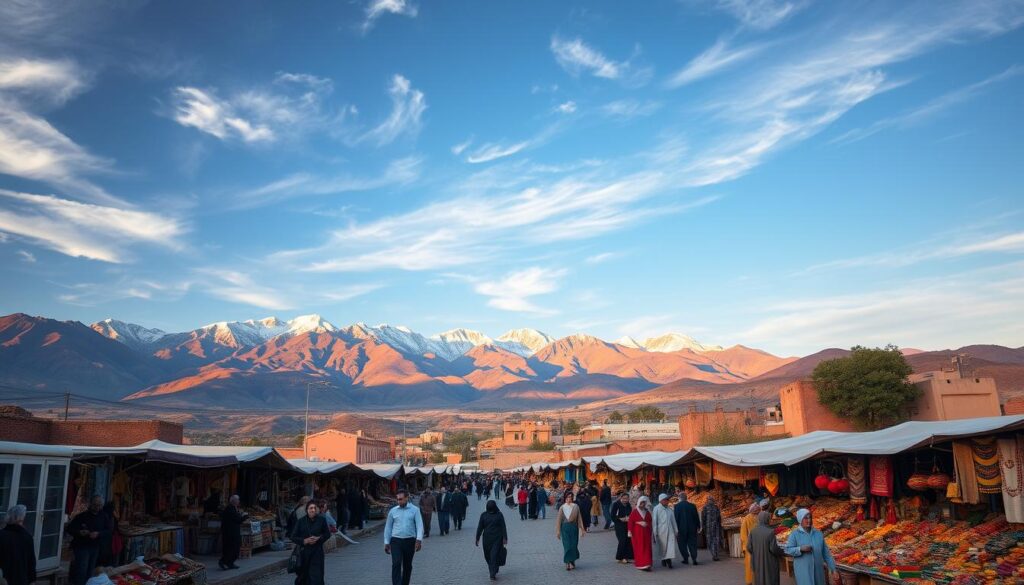
A Land of Contrasts and Beauty
Morocco is a country of contrasts, where modern cities coexist with ancient traditions. The country’s diverse landscapes, from coastal beaches to mountain villages and desert camps, offer a unique experience for travelers. Morocco’s rich historical narrative, which spans millennia, has left tangible marks on the landscape and culture.
What Makes Morocco a Must-Visit Destination
So, why visit Morocco? The country offers exceptional value for travelers, with luxury experiences available at prices significantly lower than comparable destinations in Europe or the Middle East. Morocco’s well-developed tourism infrastructure makes it accessible to various travel styles, from independent backpackers to luxury seekers.
| Reasons to Visit Morocco | Experiences to Enjoy |
|---|---|
| Cultural diversity | Explore vibrant cities and traditional villages |
| Rich history | Visit ancient ruins and historical landmarks |
| Breathtaking landscapes | Relax on coastal beaches or trek in the Atlas Mountains |
For more information on planning your trip to Morocco, contact us at +16823085820 / +212773081754 or [email protected].
Diverse Landscapes That Take Your Breath Away
Morocco is a country of striking contrasts, where the beauty of its diverse landscapes will leave travelers in awe. The country’s geography is as varied as it is breathtaking, featuring snow-capped mountains, vast deserts, and a long coastline along the Atlantic Ocean and Mediterranean Sea.
From Snow-Capped Atlas Mountains to Vast Deserts
Morocco’s interior is marked by the majestic Atlas Mountains, where snow-capped peaks offer a serene escape and a playground for outdoor enthusiasts. In stark contrast, the Sahara Desert beckons with its vast expanses of golden sand dunes, an otherworldly landscape that has captivated travelers for centuries. Visitors can travel through these diverse landscapes, experiencing the unique charm of each region.
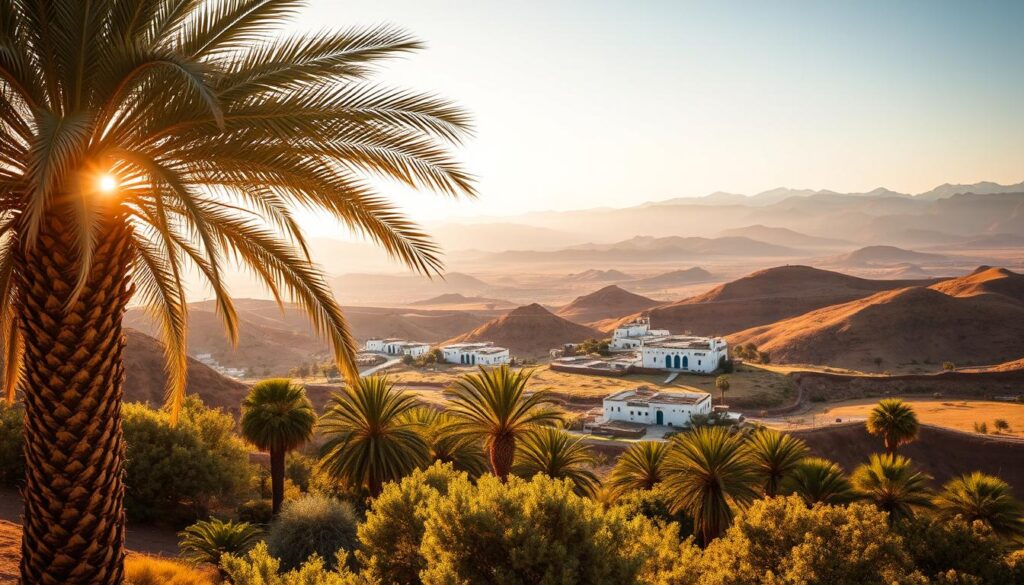
Coastal Charm and Rural Beauty
Along Morocco’s 1,200-mile coastline, one can find bustling port city like Tangier, tranquil fishing villages, and windswept beaches popular with surfers. Essaouira, a favorite among tourists, offers a relaxed atmosphere, fresh seafood, and a vibrant artistic community. Day tour from major cities can provide access to rural Morocco, where traditional farming methods continue, and weekly souks serve as commercial and social hubs. Exploring these places reveals the authentic charm of Morocco, making for a memorable day out.
| Region | Landscape | Activities |
|---|---|---|
| Atlas Mountains | Snow-capped peaks | Hiking, skiing |
| Sahara Desert | Golden sand dunes | Camel treks, camping |
| Coastal areas | Beaches, ports | Surfing, seafood dining |
The Magical Sahara Desert Experience
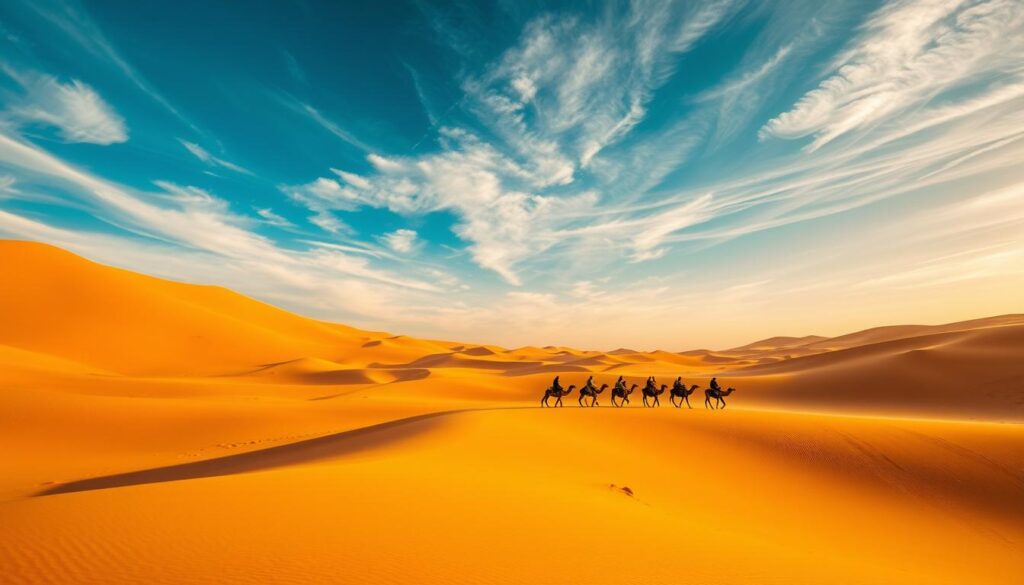
As the sun sets over the Sahara, the desert transforms into a magical world, full of mystery and enchantment. The Sahara Desert tour offers an unforgettable experience, where one can immerse in the vastness of the desert landscape.
The adventure begins with a camel trek across the golden dunes, a quintessential Sahara experience that allows travelers to explore the vast expanse of the desert.
Camel Treks Across Golden Dunes
A camel trek through the Sahara’s golden sands is an exhilarating experience, offering a unique perspective on the desert’s majestic landscape. As you ride across the undulating dunes, the rhythmic pace of the camel and the endless expanse of sand create a sense of tranquility and wonder.
Sleeping Under the Stars in Berber Camps
As night falls, the Sahara Desert transforms into a celestial showcase, with the absence of light pollution revealing a night sky of extraordinary clarity. In traditional Berber camps, travelers can enjoy sand-dune surrounded accommodations, ranging from simple tents to luxurious “glamping” experiences, and immerse in the local culture through traditional music and storytelling.
The profound silence of the desert night creates a rare opportunity for reflection and contemplation, making the Sahara Desert experience truly unforgettable.
Exploring Morocco’s Imperial Cities and Ancient Medinas
Exploring Morocco’s imperial cities is like stepping into a different era, where ancient traditions and modern life blend seamlessly. The imperial cities of Morocco, including Fez and Marrakech, are renowned for their historical significance, architectural beauty, and vibrant cultural heritage.
Getting Lost in the Maze-Like Streets of Fez
Fez, with its ancient medina, is a labyrinth of narrow streets and alleys that invite exploration. The city’s historic architecture, including mosques, madrasas, and traditional riads, offers a glimpse into its rich past. As you navigate the maze-like streets, you’ll discover hidden gems and experience the local culture firsthand.
- The ancient medina of Fez is a UNESCO World Heritage Site, recognized for its well-preserved architecture and historical significance.
- The city’s traditional craftsmanship, including pottery, textiles, and metalwork, is still practiced in the medina’s souks and workshops.
The Vibrant Energy of Marrakech
Marrakech, known as the “Red City,” is a bustling metropolis that embodies the spirit of Morocco. At night, the famous Jemaa el-Fnaa square transforms into a vibrant carnival of food stalls, storytellers, musicians, and performers, creating a truly immersive experience. A guided tour of Marrakech at night offers a unique perspective on the city, with its historic monuments illuminated against the evening sky.
The city’s architecture is a blend of traditional and modern styles, with stunning examples like the Bahia Palace and the Koutoubia Mosque. As you explore the city’s streets, you’ll encounter a diverse array of people, from locals to tourists, all contributing to the city’s dynamic atmosphere.
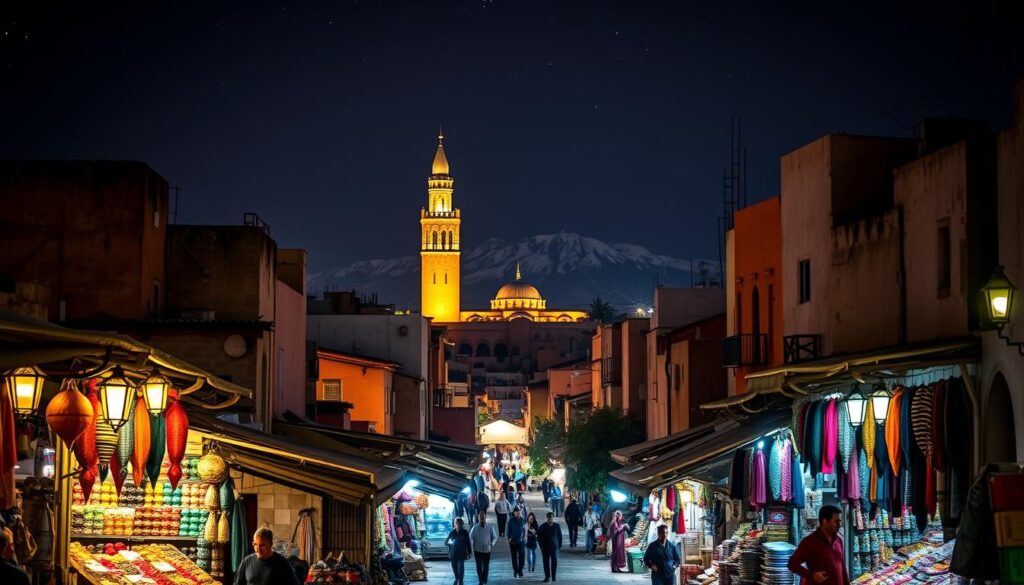
- Marrakech’s Jemaa el-Fnaa square is a dynamic public space that comes alive at night with food stalls, performers, and storytellers.
- The city’s architectural highlights include the Bahia Palace, Ben Youssef Madrasa, and the iconic Koutoubia Mosque.
Why Visit Morocco: A Feast for Food Lovers
When visiting Morocco, one of the most delightful experiences is exploring its vibrant food culture. Moroccan cuisine is a rich tapestry of flavors and aromas, influenced by the country’s strategic position at the crossroads of Africa, the Mediterranean, and the Arab world.
Tagines, Couscous, and Culinary Traditions
Moroccan cuisine is characterized by its hearty dishes, such as tagines and couscous, which are staples in every Moroccan household. A tagine is a slow-cooked stew made with meat, vegetables, and dried fruits, typically cooked in a clay pot with a conical lid. Couscous, on the other hand, is a traditional North African dish made from semolina flour, often served with vegetables and meat. These dishes are not just meals; they are a reflection of Morocco’s rich culinary traditions and cultural heritage.
| Dish | Description |
|---|---|
| Tagine | Slow-cooked stew made with meat, vegetables, and dried fruits. |
| Couscous | Traditional North African dish made from semolina flour, often served with vegetables and meat. |
The Art of Mint Tea and Moroccan Hospitality
The art of mint tea is an integral part of Moroccan hospitality. Mint tea is more than just a beverage; it’s a symbol of welcome and respect. The preparation of mint tea is a ceremonial process that involves brewing strong green tea, adding fresh mint leaves, and sugar, and then pouring it from a height to create a frothy top. This ritual is a demonstration of the host’s hospitality skills and is often the first thing offered to visitors in homes, shops, and during business negotiations.
As one traveler noted, “I’ve never drunk more tea than when I was in Morocco. In a country where ‘having a beer’ is not a thing, locals substitute pots of mint tea. There’s even an art to pouring it: the higher the teapot, the better.” This experience highlights the significance of mint tea in Moroccan culture and its role in fostering social connections and hospitality.
“Moroccan mint tea is far more than a beverage – it’s a symbol of hospitality, a social ritual, and often the first thing offered to visitors.”
The tradition of mint tea reflects Morocco’s position at the crossroads of trade routes, combining Chinese green tea with locally grown mint and abundant sugar. Visitors are often invited to share tea with locals, creating authentic cultural exchanges that provide insights into Moroccan daily life and values.
Rich Cultural Heritage and Historical Treasures
Morocco boasts an incredible array of historical and cultural attractions. The country’s diverse history has created a unique blend of cultural influences, visible in its architecture, art, and traditions.
UNESCO World Heritage Sites and Ancient Ruins
Morocco is home to numerous UNESCO World Heritage Sites, including ancient ruins that tell the story of its rich past. The city of Essaouira, with its fortified walls, and the ancient Roman site of Volubilis are notable examples. These sites not only showcase the country’s historical significance but also its architectural diversity.
- The ancient city of Meknes, with its Roman ruins and historical monuments.
- The medina of Fez, a well-preserved ancient town with a rich history.
- The archaeological site of Chellah, near Rabat, featuring Roman and Islamic ruins.
The Blue City of Chefchaouen and Other Hidden Gems
Nestled in the Rif Mountains, the city of Chefchaouen, known as “The Blue Pearl,” is famous for its blue-washed buildings, creating a picturesque scene unlike anywhere else in the world. Visitors can wander through its charming streets, taking in the unique architecture and enjoying the relaxed atmosphere.
Other hidden gems include the historic town of Tetouan, with its UNESCO-protected medina, and Taroudant, often referred to as “Little Marrakech” due to its impressive ramparts. These destinations offer a glimpse into Morocco’s rich cultural heritage, shaped over time by various influences, including its unique architecture.
Vibrant Markets and Traditional Craftsmanship
Exploring Morocco’s souks is like stepping into a world of vibrant colors, enticing aromas, and rich cultural heritage. These markets are a testament to the country’s living traditions of craftsmanship.
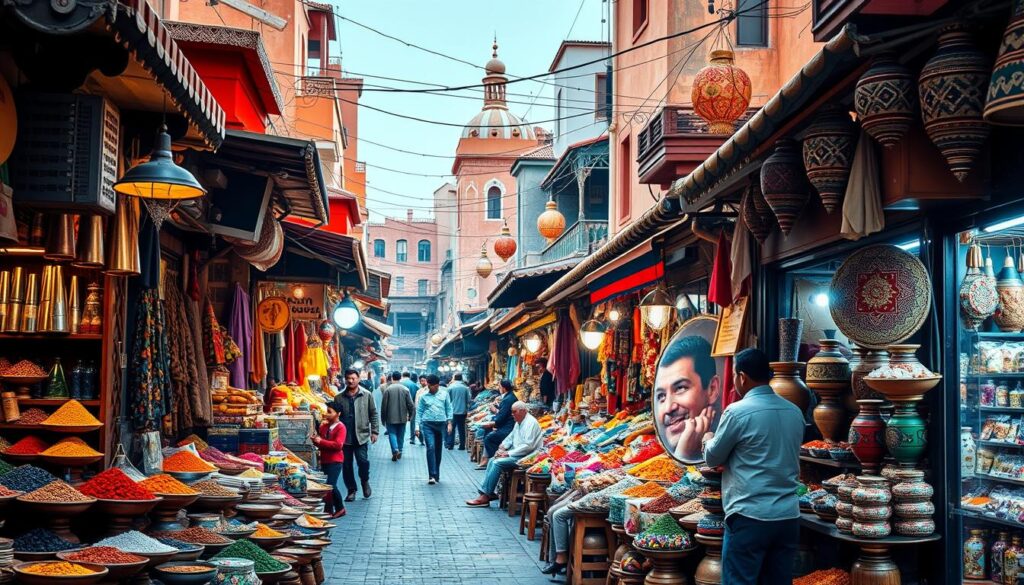
Navigating the Colorful Souks
Navigating Morocco’s colorful souks can be a daunting task, but with some insider knowledge, it can become a truly rewarding experience. The key is to understand that haggling is not just about reaching a mutually agreeable price; it’s a social interaction that locals enjoy.
To navigate these markets effectively, start by understanding the local customs and being respectful. Begin negotiations at about 20-25% of the initial asking price, and be prepared to walk away if the deal isn’t right. Comparing prices across multiple vendors can also help you get a fair deal.
Artisanal Treasures and Haggling Tips
Morocco is renowned for its artisanal heritage, which includes leather working, carpet weaving, pottery, metalwork, and woodcarving. When shopping for these artisanal treasures, remember that successful haggling requires a friendly and respectful attitude.
Budget-conscious travelers can find authentic souvenirs at various price points. For those concerned about authenticity and ethical shopping, consider visiting government-sponsored cooperatives or women’s associations, which offer fair-trade products with fixed prices that directly support artisans.
Tips for Shopping in Moroccan Souks:
- Start negotiations at about 20-25% of the initial asking price.
- Be willing to walk away to negotiate a better deal.
- Compare prices across multiple vendors.
- Maintain a friendly and respectful attitude throughout the haggling process.
Plan Your Moroccan Adventure Today
Morocco, a land of contrasts, beckons travelers with its vibrant culture, stunning natural beauty, and warm hospitality. As you plan your trip to Morocco, you’ll find that the country offers a wide range of places to stay, suitable for any budget. Whether you opt for a luxury riad or a simple guesthouse, Morocco has something to offer.
The best times to visit Morocco are during spring (March to May) and fall (September to November), when temperatures are pleasant throughout the country. A well-planned Morocco itinerary typically includes at least one imperial city, a desert experience, time in the mountains or coast, and plenty of opportunities to engage with local culture through food, markets, and historical sites.
Families traveling with children will find Morocco surprisingly accommodating, with many riads and hotels offering family rooms and guides who can tailor experiences to younger travelers. To save money, consider staying in guesthouses, eating at local food stalls, and using public transportation between major cities.
For an expertly guided experience, our tour company offers customized itineraries led by knowledgeable local guides who can unlock Morocco’s hidden treasures. Whether you’re drawn by the allure of the Sahara desert, the maze-like medinas, or the distinctive cuisine, Morocco offers countless reasons to visit.
Contact us today at +16823085820 / +212773081754 or email [email protected] to begin planning your Moroccan adventure with experts who can help craft an itinerary perfectly suited to your interests, timeframe, and budget.